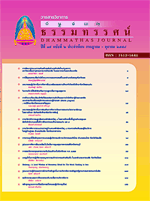Hodsong : A Local Wisdom of Monastery Ritual for The Monk Ranking in Isan
Main Article Content
Abstract
Thailand was influenced mostly from Buddhist beliefs and practices starting from Lanchang period, and this religious beliefs became the common practices and the tool for local community in strengthening harmony and unity. One of the important religious ceremonies called Hodsong ceremony.
Research area are involved with 3 provinces-Mahasarakham, Roi-Et, and Kalasin where there are many Monk’s hierarchy ceremony. Sampling groups comprised of 15 key informants, 15 casual informants, and 30 general informants, in total of 66 informants.
The research finings are 1) Hodsong ceremony of Isan people was evidentially found since Dvaravati period, Sukhothai (Lanna), Lan Chang, Ayuthaya, Thonburi and Rattanakosin period. It was approved from different archeological sites such as PrathatYakhu, Um Yakhu, etc. and the other kind of evidence as has been recognized as a position or ranking such as Ratchakhru, and Lakkham for instance. In addition, there were some equipment that was involved within this ceremony such as the water tube or Honghod was found at Wat Wichunrat and Wat Chiangthong, and then different temples in Isan. The Laab or Supannabat (a golden plate used for in scripted manuscript) was rarely found,and most of remains were reproduced. 2) Hodsong ceremony is a religious tradition of Isan people that combined the ritual and belief together (Klausner: 1972). Currently, local Isan people still practice this ceremony in some communities with the 8 steps of 1) preparation of instruments, 2) Hodsong ornaments ,3) the itinerary order of the ceremony, 4) the ceremonial location, 5) the establishing ritual , 6) Baisri setting, 7) Sootkhwanbaisri or morale setting, 8) consoling and tied arms tradition. In addition, this ceremony involved with beliefs of direction and occasion from traditional beliefs (Tambiah: 1970). Despite, there were some problems such as unqualified monks, insufficient equipment and the ornaments, as well as the unreadiness from the community to continue this practice. 3) The appropriate approach in order to preserve and develop this practice has to deal with the dynamics of community through 8 approaches as follows, 1) the benefits to the community, 2) the catchment, 3) remaining or repairing, 4) restoring, 5) explicate or develop, 6) protection, 7) preservation and, 8) demarcation and classification or setting rules or regulations for preservation. Therefore, the public administration or government, private sector and community need to have an awareness and conservation to work together urgently.
The Hodsong ceremony has a longhistory and been practiced since Dvaravati period. The contemporary Hodsong ceremony was made into an illegal or alienated tradition of Thai state which effects to the remaining practice of community. Other wises, The Hodsong ceremony to meet theneeds of the harmony and unity of community.